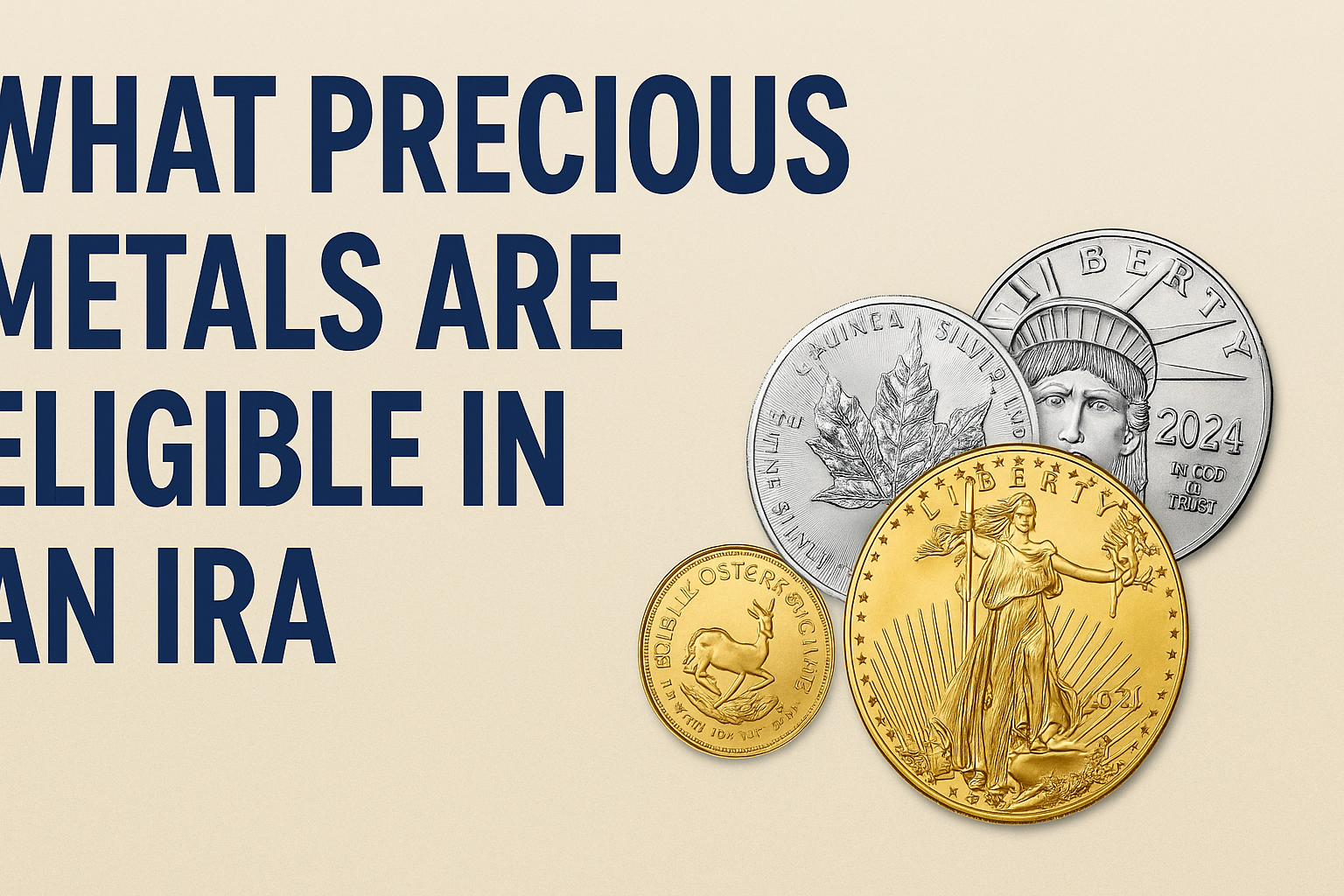If you’re thinking about retirement planning and looking to diversify your investment portfolio, you’ve probably heard of a Precious Metals IRA. Unlike traditional IRAs, which are generally limited to stocks, bonds, and mutual funds, a self-directed IRA allows you to invest in a range of assets—including precious metals like gold, silver, platinum, and palladium.
But not just any gold coin or silver bar qualifies. The IRS has set specific rules about the types and purities of metals that are allowed in an IRA. Let’s walk through everything you need to know about eligible precious metals in an IRA, and how you can make informed decisions to protect and grow your retirement savings.
Why Invest in Precious Metals Through an IRA?

Before diving into the details, let’s explore why this might be a smart move.
Precious metals offer:
- Hedge against inflation
- Portfolio diversification
- Tangible assets with intrinsic value
- Crisis protection in times of geopolitical or financial instability
If you’ve ever watched the stock market plummet and felt that pang of anxiety, you understand the value of having a safety net. Precious metals can be that safety net.
IRS Guidelines for Precious Metals in an IRA
Not every shiny metal qualifies. The IRS has rules regarding metal type, fineness, and storage. Here’s a summary:
1. Gold
- Must be at least 99.5% pure
- Common eligible coins include:
- American Gold Eagle (only bullion and proof coins)
- Canadian Gold Maple Leaf
- Australian Kangaroo/Nugget
- Austrian Philharmonic
2. Silver
- Must be at least 99.9% pure
- Eligible coins and bars include:
- American Silver Eagle
- Canadian Silver Maple Leaf
- Austrian Philharmonic
- Mexican Libertad
3. Platinum
- Must be at least 99.95% pure
- Accepted coins:
- American Platinum Eagle
- Canadian Platinum Maple Leaf
4. Palladium
- Must also be 99.95% pure
- Most common: Canadian Palladium Maple Leaf
Additional Rules
- Must be produced by a certified refiner/manufacturer
- Must be stored in an IRS-approved depository
Coins vs. Bars: What Should You Choose?
Both coins and bars are allowed, but there are some things to consider:
Coins:
- Easier to trade
- Often carry a premium
- Widely recognized and accepted
Bars:
- Lower premiums over spot price
- Ideal for large-volume investments
For beginners, coins like the American Gold Eagle or Silver Maple Leaf are a great place to start.
What Is Not Allowed in a Precious Metals IRA?
Just as there are approved metals, there are prohibited items too. These include:
- Collectible coins (e.g., numismatics)
- Jewelry
- Foreign coins not meeting purity standards
Even if a gold coin is 24-karat, if it’s not on the IRS-approved list, it can’t be included.
Be cautious of any dealer promising you rare coins with historical value for your IRA—those are typically not allowed and may carry high markups.
How to Set Up a Precious Metals IRA
Setting up a Precious Metals IRA is easier than you might think. Here are the steps:
- Choose a self-directed IRA custodian: Not all custodians offer metal IRAs. Look for one with experience in precious metals.
- Open and fund your IRA: You can fund it with a rollover from an existing retirement account or a direct contribution.
- Select your metals: Work with your custodian and a trusted dealer to choose eligible metals.
- Storage: Metals must be stored at an IRS-approved facility. Home storage is not permitted.
Benefits of a Precious Metals IRA
- Tax advantages: Enjoy tax-deferred or tax-free growth depending on the type of IRA.
- Protection against market volatility: Precious metals often perform well when traditional assets drop.
- Long-term security: Metals have maintained value for thousands of years.
A well-rounded retirement plan doesn’t rely on one type of asset. Adding metals can be the missing puzzle piece.
Risks and Considerations
While there are clear advantages, it’s important to understand the risks:
- Price volatility: Metal prices can swing significantly.
- No dividends or interest: Unlike stocks, metals don’t generate income.
- Storage and insurance fees: These can eat into your returns over time.
That’s why it’s crucial to speak with a financial advisor or retirement expert before diving in.
How to Buy Eligible Metals for Your IRA
You can’t just go to a jewelry store and start buying. Here’s how to do it properly:
- Work with a reputable dealer: Ensure they understand IRS rules.
- Verify purity and eligibility: Don’t take the dealer’s word for it—ask for certifications.
- Coordinate with your custodian: They will handle the actual purchase and storage logistics.
Real-Life Example: Sarah’s Story
Sarah, a 50-year-old business owner, wanted to safeguard her retirement from market ups and downs. After speaking with a retirement specialist, she allocated 20% of her IRA into a mix of gold and silver coins.
Within two years, the value of her metals increased, and she felt more confident in her overall portfolio. While she still keeps traditional investments, her metals provide peace of mind.
“Having that tangible asset really balances out the digital chaos of the market,” Sarah says.
Final Thoughts
A Precious Metals IRA isn’t for everyone—but for those looking to diversify, protect, and potentially grow their retirement wealth, it can be a powerful tool.
Just remember:
- Stick to IRS-approved metals
- Work with professionals
- Understand the costs and benefits
Your future deserves the shine of something timeless. Precious metals may just be the treasure map to your financial peace of mind.
